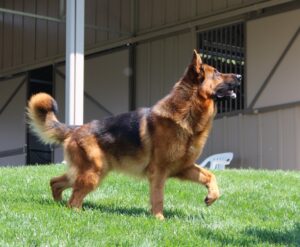German Shepherds are a popular breed known for their intelligence, loyalty, and trainability. However, they also have unique physical characteristics, such as their ears, that require special attention regarding grooming and care. German Shepherds have large, pointed ears prone to infections and other issues if not correctly cared for. This article will provide a comprehensive guide to German Shepherd ears, including how to clean and care for them, common issues to look out for, and tips for preventing ear problems.
German Shepherds have erect ears that are a distinctive feature of the breed. The ears are typically triangular and stand upright when the dog is alert. Some German Shepherds may have their ears cropped, which is a procedure that involves surgically removing part of the ear to make them stand up more erect.
Moreover, German Shepherd ears are typically pointed and erect. Some German Shepherds may have ears that flop over, resulting from a lack of cartilage in the ear. This is a common trait among German Shepherds and is not a concern for their health.
However, if the ears are floppy and not standing up by the time the dog is six months old, the breeder may have to tape the ears to help them stand.
German Shepherd ears

German Shepherd ears are typically erect, but a genetic variation can lead to floppy ears. This is known as “soft ears” and is more common in show-line German Shepherds. They can train the ears to stand up through a process known as “ear taping,” which involves gently and gradually shaping the ear cartilage to stand erect.
However, this process should only be done by experienced handlers and with care to avoid injury to the ears. It is important to note that while many German Shepherd owners prefer the look of erect ears, it does not affect the health or well-being of the dog.
German Shepherds’ ears are sensitive and vital for them in terms of communication and navigation. Erect ears help them to hear better and locate sounds, while floppy ears can make it more difficult for them to hear.
Moreover, a German Shepherd with floppy ears can still be a healthy and well-adjusted dog as long as they are properly cared for.
Also, note that ear taping should only be done by experienced handlers and under the guidance of a veterinarian or professional dog trainer. It is a gradual process that requires patience and consistency and should do it with care to avoid injury to the ears. Remember that ear taping does not guarantee that the ears will stand up permanently, and some dogs may not respond well to it.
How to train German Shepherd ears to stand up
Training German Shepherd ears to stand up is a process known as “ear taping.” It should only be done by experienced handlers and under the guidance of a veterinarian or professional dog trainer. Here are the general steps for ear taping:
- Start when the puppy is about 8-10 weeks old. This is when their ears begin to stand, but they are still pliable enough to be shaped.
- Clean the ears with a mild, non-alcoholic solution to remove dirt or debris.
- Cut small strips of medical tape and place them on the back of the ears, starting at the base and working your way up. The tape should be applied in a V-shape, with the point of the V at the top of the ear.
- Check the ears daily and adjust the tape to maintain the V-shape.
- Gradually increase the length of the tape as the ears stand more erect.
- Continue the process for several months until the ears stand up independently.
- Once the ears stand up, reduce the frequency of taping until you can stop taping altogether.
Ensure that you should do ear taping carefully to avoid injury to the ears. Check the ears regularly for any signs of redness, irritation, or infection.
Also, not all German Shepherds respond well to ear taping, and some may not have ears that will stand up permanently. And, even if ears stand up, it doesn’t affect the health or well-being of the dog.
What is the German Shepherd ear cropping age?

Ear cropping is a surgical procedure performed on some breeds of dogs, including German Shepherds, to shape their ears. The age at which ear cropping is performed varies depending on the specific species and the preference of the breeder or owner.
For German Shepherds, ear cropping is typically done between 7 and 12 weeks of age. This is because the puppy’s ear cartilage is still soft and pliable at this age, making it easier to shape the ears. The procedure is done under general anesthesia and performed by a veterinarian who is experienced in ear cropping.
Always note that ear cropping is a controversial and painful procedure banned in some countries and some states in the US. It’s also considered unnecessary and inhumane by some animal welfare organizations, as it serves only aesthetic reasons and can cause pain, discomfort, and even infections.
Furthermore, ear cropping does not affect the dog‘s health, hearing, or well-being, and it’s not necessary for the dog’s physical capabilities.
Why are German Shepherds floppy ears?
German Shepherds are a dog known for their distinctive pointed, erect ears. However, some German Shepherds may have ears that flop over, resulting from a lack of cartilage in the ear. This genetic variation is more commonly seen in show-line German Shepherds.
In addition, it can train the ears to stand up through a process known as “ear taping,” which involves gently and gradually shaping the ear cartilage to stand erect.
A dominant gene causes the genetic variation that causes floppy ears in German Shepherds. If a puppy inherits the gene from one parent, their ears will be floppy. If a puppy inherits the gene from both parents, the chances of floppy ears are even greater.
It’s important to note that having floppy ears does not affect the health or well-being of the dog. German Shepherds with floppy ears can still hear and navigate just as well as those with erect ears. And ear taping does not guarantee that the ears will stand up permanently, and some dogs may not respond well to it.
It’s also worth noting that ear taping is controversial and considered unnecessary by many animal welfare organizations, as it serves only for aesthetic reasons. It can cause pain, discomfort, and even infections.
Why are my German Shepherd ears not standing up?

There are several reasons why your German Shepherd’s ears may not be standing up:
- Genetics: As mentioned earlier, some German Shepherds have floppy ears due to a genetic variation. If your dog has inherited the gene for floppy ears from one or both parents, their ears may not stand up.
- Age: German Shepherd puppies’ ears typically begin to stand up between 8-10 weeks. If your puppy is not yet at this age, their ears may not stand up.
- Ear Taping: If you have been taping your German Shepherd’s ears and the process needs to be done correctly or with care, it may not have been effective in getting the ears to stand up.
- Health: Some health conditions, such as ear infections, mites, or other ear problems, can cause the ears to droop. If your dog is experiencing any symptoms, such as scratching at the ears, head shaking, or discharge from the ears, it’s best to take them to the vet to rule out any underlying health issues.
- Training: Sometimes, lack of proper training or socialization can affect the dog’s confidence, which can affect the ears’ position.
Can German Shepherd ears be trained to stand later in life?
It is possible to train German Shepherd ears to stand later in life, but it is generally more complex and less successful than teaching them when the dog is a puppy. The ear cartilage of a puppy is still soft and pliable, making it easier to shape and train the ears to stand up. As a dog ages, the ear cartilage becomes more rigid, making it harder to shape and train the ears.
Additionally, ear taping can be more painful and uncomfortable as the dog ages. It’s also important to note that not all adult German Shepherds will respond well to ear taping, and some may not have ears that stand up permanently.
Check with a veterinarian or a professional dog trainer to see if ear taping is viable for your adult German Shepherd. They can provide more information on the procedure and the risks and benefits.
How to clean German Shepherd ears?

To clean a German Shepherd’s ears, you will need the following items: cotton balls or pads, ear cleaning solution, and a towel. Here are the step by step process to clean German Shepherd ear:
- Start by gently lifting the German Shepherd’s ear flap and use the towel to wipe away any excess hair or debris around the ear canal.
- Next, use a cotton ball or pad to apply the ear cleaning solution to the inside of the ear flap, being careful not to insert anything into the ear canal.
- Gently massage the base of the ear to help loosen any debris.
- Use the cotton ball or pad to wipe away any debris and use a cleaning solution.
- Repeat the process on the other ear.
It’s better to avoid using cotton swabs or any other items that can insert into the ear canal as it can cause injury.
What are German Shepherd ear infection symptoms?
German Shepherd ear infections can have several symptoms, including:
- Itching or scratching of the ears
- Redness or swelling of the earflap or ear canal
- Odor coming from the ears
- Dark, waxy, or yellow discharge from the ears
- Shaking the head or holding the head tilted to one side
- Loss of balance or difficulty walking
- Loss of appetite or decreased activity levels
- Whining or whimpering while scratching the ears
- Hair loss around the ears
It’s vital to note that not all ear infections will exhibit all of these symptoms, and some may only show a few.
How to prevent German Shepherd ear infections?

Preventing ear infections in German Shepherds can be done through regular ear cleaning, avoiding exposure to excessive moisture, and addressing underlying health conditions.
- Regular Ear Cleaning: Regularly cleaning your German Shepherd’s ears using a gentle ear-cleaning solution and cotton balls or pads can help prevent the buildup of wax and debris that can lead to infections.
- Avoiding Excessive Moisture: Keeping your German Shepherd’s ears dry can help prevent ear infections. You can do this by keeping your dog‘s ears dry after bathing or swimming and avoiding exposing them to excessive moisture, like rain or snow.
- Addressing Underlying Health Conditions: Some German Shepherds may be predisposed to ear infections due to underlying health conditions, such as allergies or hypothyroidism. Addressing these underlying conditions through proper treatment and management can help reduce the risk of ear infections.
- Keep their ears dry and clean, and trim the hair around the ear canal to reduce the chance of bacteria and yeast buildup.
Some German Shepherds may be more prone to ear infections due to their ear shape, and some may have a greater risk due to underlying health conditions. In this case, it’s essential to consult a veterinarian for proper management.
What is a German Shepherd ear cropping cost?
The cost of ear cropping for a German Shepherd can vary depending on several factors, such as the location, the surgeon’s experience, and the specific type of crop that is performed.
On average, the cost of ear cropping for a German Shepherd can range from $800 to $1500. This cost can include the initial surgery, post-operative care, and follow-up visits. However, in some cases, the price can be higher or lower depending on the abovementioned factors.
Moreover, ear cropping is considered a cosmetic procedure and is not medically necessary for the dog’s well-being. Also, ear cropping is illegal or restricted in some countries and states, so check the local laws before considering the procedure.
It’s highly recommended to check the credentials, qualifications, and experience of the veterinarian performing the procedure and to visit the facility and ask questions before making a decision.
How long does it take for German Shepherd ears to stand up?

Typically, German Shepherd puppies are born with floppy ears, and their ears will begin to stand up between 8 and 12 weeks of age. However, some German Shepherds may take longer for their ears to stand up, and in some cases, they may only stand up partially.
Some German Shepherd breeds have been selectively bred to have naturally standing ears, while others may have a greater chance of having floppy ears. Additionally, nutrition and overall health can play a role when a German Shepherd’s ears stand up.
Are German Shepherd ears standing up at different ages?
German Shepherd puppies are typically born with floppy ears. They usually begin to stand up between 8-12 weeks of age, but it can take up to 6 months for the ears to fully stand.
However, some German Shepherds may have ears that never stand up. This is not a health concern and does not affect their hearing ability. Several factors can influence when German Shepherd ears stand up.
Moreover, Some puppies may have ears that stand up earlier than others, while others may take longer. Some German Shepherds may have ears that never stand up. This is not a health concern and does not affect their hearing ability.
The process of ears standing up is known as “ear-cropping,” an elective surgical procedure that can be done when the puppy is young. This is done to make the dog look like a typical German Shepherd. However, ear-cropping is illegal in some countries, and some people choose not to do it for ethical reasons.
In addition, nutrition and environment also play a role in the development of the ears. Puppies with nutritional deficiencies or poor living conditions may take longer for their ears to stand up.
Why are my German Shepherd ears standing up one and not the other?

One possibility is that the ear not standing up may have a different shape or structure than the other ear, which can affect its ability to stand up. Additionally, the ear muscles may be weaker on one side, making it more difficult for that ear to stand up.
Another possibility could be an injury or infection in the ear that is not standing up, which can affect its ability to stand up. In this case, you should take your German Shepherd to the vet for a check-up.
Also, It could be due to genetics, some German Shepherds are born with one ear that is more floppy than the other, and it may never stand up. This is not a health concern and does not affect their hearing ability.
Finally, the ears stand up, and one ear takes longer than the other. Give it time and monitor the situation. If you see any signs of pain or discomfort, consult your veterinarian.
Why are my German Shepherd ears standing up after cropping?
If your German Shepherd’s ears stand up after cropping, it could be for many reasons. The ear cartilage was not cut correctly during the cropping procedure, which can affect the ability of the ear to stand up.
Additionally, the ear muscles may have needed to be adequately trained to hold the ears up during the healing process.
Another possibility is that the ears were not taped or bandaged correctly after the cropping procedure. This can affect the shape of the ears and make it more difficult for them to stand up.
Also, the ears are likely healing well and standing up as expected. Some German Shepherds may take longer for the ears to stand up after cropping. It could take weeks or even months.
If you are concerned about the standing of the ears, it’s best to consult the veterinarian or professional who performed the procedure. They will be able to examine your dog and determine if there is an issue and what steps can be taken to correct it.
Can German Shepherd ears stand up naturally?

German Shepherd ears can stand up naturally without cropping. Some German Shepherds are born with ears that stand up naturally, while others may take longer for their ears to stand up. The process of ears standing up is known as “ear-cropping,” an elective surgical procedure that can be done when the puppy is young.
However, ear-cropping is illegal in some countries, and some people choose not to do it for ethical reasons. The ears standing up naturally is not an overnight process, it can take weeks or even months for the ears to stand up, but it can be different from one puppy to another. It depends on the puppy‘s genetics and environment.
Conclusion
In conclusion, German Shepherd ears are a unique and defining feature of the breed. Puppies are typically born with floppy ears, which will begin to stand up between 8-12 weeks of age, but it can take up to 6 months for the ears to fully stand.
However, some German Shepherds may have ears that never stand up. This is not a health concern and does not affect their hearing ability. The process of ears standing up is known as “ear-cropping,” an elective surgical procedure that can be done when the puppy is young but is illegal in some countries and considered unethical by some people.
Also, the puppy’s nutrition and environment play a role in the development of the ears. It is important to remember that even if the ears do not stand up, it does not affect the dog’s hearing or health. If you are concerned about your German Shepherd‘s ears, it’s best to consult a veterinarian to rule out any underlying health issues.


